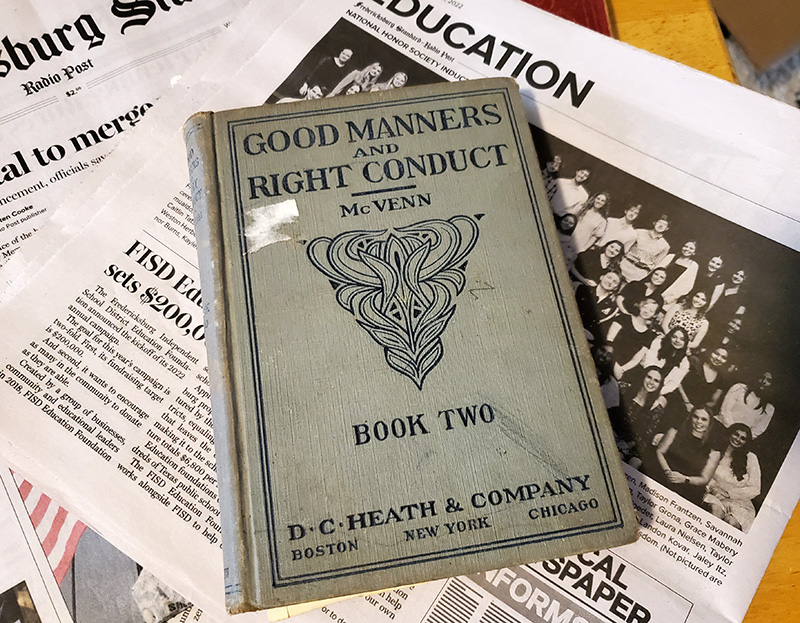
Nov 23, 2022–As you sit down to your Thanksgiving Day meal, I am confident you will observe the list of manners to be followed “At Table:”
- Promptness when meals are announced
- When to sit; position; fidgeting
- Waiting one’s turn
- When to begin to eat
- How to eat and drink
- Use of napkin, knife, fork, and spoon
- How to ask for food
- How to choose topics of conversation
- Use of toothpicks
- Leaving the table
Already, I’ve lost 80% of readers. Just the first one – “when meals are announced” leaves many perplexed. Who announces a meal anymore, let alone chooses topics of conversation or discusses the use of toothpicks?
These guidelines are gleaned from Good Manners and Right Conduct, Book Two, written by Gertrude McVenn and published in 1918. (How it found its way onto my bookshelf I have yet to figure out. Hopefully it wasn’t planted.)
Meant as a guide for school teachers in manners training, the 250-page tome is a dense bible for social behavior on all fronts.
“The aim should be to establish in your pupils the habits of thought and of conduct that will make them helpful members of society,” McVenn states. “To do this they should be made to practice helpfulness in the school, to have a sense of responsibility for the general good; to feel a sense of personal injury when some wrong interrupts the smooth working of the school, and of pride in the successful carrying out of the various school activities.”
Let’s go to school.
To reinforce Table Manners, there follows a 12-page play depicting the correction of a country lad’s bad table manners. Twelve pages! They include:
- Saying “No, I thank you,” when refusing anything, or “Yes, thank you,” when accepting.
- “Allow me,” on picking up and presenting an article dropped; “Thank you,” upon receiving the article. Offering a seat, and declining a seat.
- Look at this Table of Contents for Ways of Addressing the Teachers:
- Interrupting
- Treatment of strangers
- Laughing at mistakes of others
- Treatment of the unfortunate
- Borrowing
Hat etiquette merits its own list. A boy should raise his hat:
- When he bows to a lady or gentleman
- When he is with a girl who bows to any person
- When he salutes a boy who is in the company of girls
- When he is in the company of another boy who bows to a lady
- When he enters a building
And on and on and on. Keeping these rules top of mind may explain why men stopped wearing fedoras.
Ladies had to follow Don’ts on Dressing:
- Don’t preen in public
- Don’t look into every mirror that you pass
- Too much powder on the face is in very bad taste
- Perfume should be used very sparingly–never at school
- Do not wear any clothing that is soiled
- Do not wear high-heeled shoes. They are not suitable for school girls. They throw the foot forward and pinch the toes. They strain the back.
Obviously the directive on wearing high heels has been ignored by subsequent pinch-toed, sore-backed generations.
It is jarring 100 years later to realize any author or teacher could declare behavior as “right” and “wrong.” One doesn’t dare advance that judgement on today’s youth for fear of in turn being judged as some type of “-ist” out of step with the latest dictates of what is considered normal. Today, simply categorizing students as ladies and gentlemen is controversial.
In the 1960s it was great sport to play at being anti-establishment and nonconformist. Today, there is no establishment to be against and little to conform to. When nonconforming becomes the norm, anyone showing manners or grace is at risk of being perceived as the radical.
So this Thanksgiving, “choose your topics of conversation” with care and enjoy your meal.